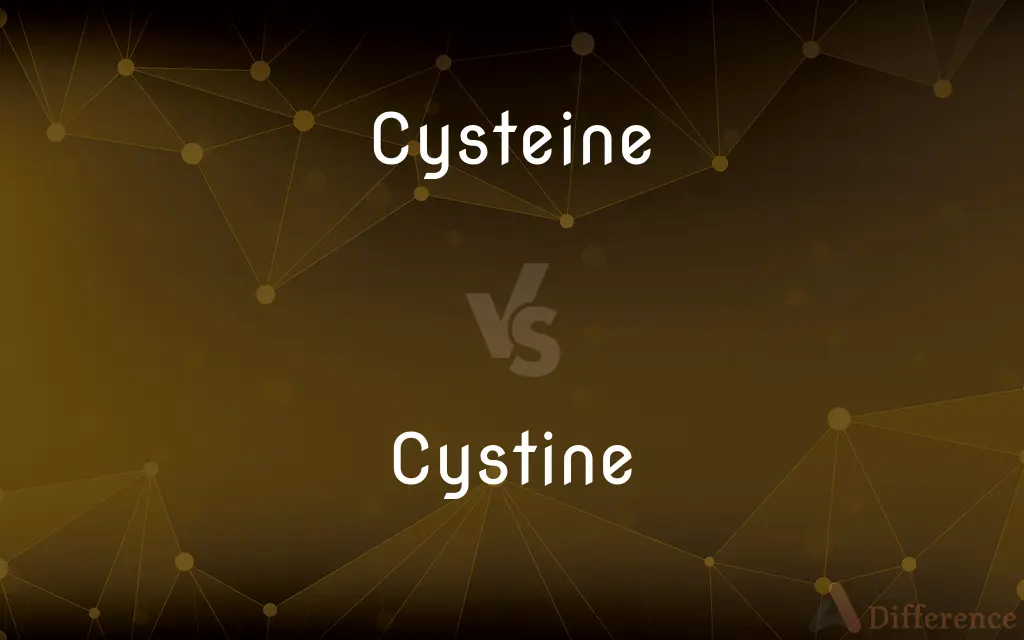Cysteine vs. Cystine — What's the Difference?
Edited by Tayyaba Rehman — By Fiza Rafique — Updated on September 25, 2023
Cysteine is an amino acid essential for protein synthesis, containing a thiol group (SH). Cystine is a compound composed of two cysteine molecules linked by a disulfide bond (SS).

Difference Between Cysteine and Cystine
Table of Contents
ADVERTISEMENT
Key Differences
Cysteine contains a single thiol (sulfhydryl) group in its structure. Cystine comprises two cysteine molecules linked by a disulfide bond, forming a dimer.
Cysteine vital for the formation of proteins, peptides, and antioxidants. Cystine plays a role in protein structure by forming disulfide bridges, contributing to their stability.
Cysteine found in many dietary sources and as a building block of proteins. Cystine often occurs when two cysteine molecules chemically combine, particularly in hair, skin, and nails.
Comparison Chart
Meaning
An amino acid with a thiol group (SH)
A compound formed by linking two cysteine molecules with a disulfide bond (SS)
Structure
Contains a single thiol group
Comprises a dimer with a disulfide bond
ADVERTISEMENT
Function
Crucial for protein synthesis and antioxidant production
Contributes to protein stability through disulfide bridges
Occurrence
Found in various dietary sources
Forms naturally in hair, skin, and nails
Compare with Definitions
Cysteine
Contains a thiol group crucial for antioxidant production.
The thiol group in cysteine helps combat oxidative stress.
Cystine
Occurs naturally in skin, nails, and proteins.
Cystine contributes to the resilience of skin and nails.
Cysteine
Plays a role in peptide and enzyme formation.
Cysteine is involved in the structure of enzymes like trypsin.
Cystine
Forms when cysteine molecules chemically combine.
Cystine arises when two cysteine units bond covalently.
Cysteine
An important component of glutathione, a powerful antioxidant.
Glutathione, rich in cysteine, protects cells from damage.
Cystine
Recognized for its role in maintaining hair strength.
Cystine bonds in hair shafts provide strength and resilience.
Cysteine
Supports the synthesis of collagen and connective tissues.
Collagen production relies on cysteine's presence.
Cystine
A compound formed by linking two cysteine molecules with a disulfide bond.
Cystine's disulfide bonds enhance the structural integrity of hair.
Cysteine
A fundamental amino acid vital for protein synthesis.
Cysteine is essential for the formation of keratin in hair.
Cystine
Important for protein stability through disulfide bridges.
The presence of cystine ensures protein structures remain intact.
Cysteine
Cysteine (symbol Cys or C; ) is a semiessential proteinogenic amino acid with the formula HOOC-CH-(NH2)-CH2-SH. The thiol side chain in cysteine often participates in enzymatic reactions as a nucleophile. The thiol is susceptible to oxidation to give the disulfide derivative cystine, which serves an important structural role in many proteins.
Cystine
Cystine is the oxidized dimer form of the amino acid cysteine and has the formula (SCH2CH(NH2)CO2H)2. It is a white solid that is slightly soluble in water.
Cysteine
An amino acid, C3H7O2NS, derived from cystine and found in most proteins.
Cystine
A white crystalline amino acid, C6H12N2O4S2, that is formed from the disulfide linkage of two cysteines during the folding of many proteins, especially keratin, and stabilizes the tertiary structure of the protein.
Cysteine
(amino acid) A sulphur-containing nonessential amino acid C3H7NO2S found in most animal proteins; it readily oxidizes to cystine.
Cystine
(chemistry) A nonessential amino acid formed by the oxidation of cysteine; it contains two cysteine residues linked by a disulfide bond.
Cysteine
An amino acid containing sulfur that is found in most proteins; oxidizes on exposure to air to form cystine
Cystine
A white crystalline substance, C3H7NSO2, containing sulphur, occuring as a constituent of certain rare urinary calculi, and occasionally found as a sediment in urine.
Cystine
A crystalline amino acid found in proteins (especially keratin); discovered in bladder stones
Common Curiosities
Is cystine naturally occurring, or does it require a specific process to form?
Cystine naturally forms when two cysteine molecules chemically combine, often in hair, skin, and nails.
What is the primary function of cysteine in the body?
Cysteine is essential for protein synthesis, enzyme activity, and antioxidant production.
Where can you find cysteine in your diet?
Cysteine is present in various dietary sources like poultry, eggs, dairy, and legumes.
Can cysteine and cystine be obtained through supplements?
Yes, supplements are available, but it's advisable to consult a healthcare professional for guidance.
In what industrial applications are cysteine and cystine used?
They are utilized in the food industry as additives, and cystine is sometimes used in hair care products.
What is the significance of cystine in hair and nails?
Cystine's disulfide bonds contribute to the structural integrity and strength of hair and nails.
Are there any known side effects or risks associated with cysteine or cystine supplements?
Excessive intake can lead to side effects, so it's crucial to follow recommended doses.
Can cysteine and cystine be obtained from vegetarian or vegan diets?
Yes, plant-based sources like soy, beans, and nuts contain cysteine and cystine.
What are some common uses of cysteine supplements in healthcare?
They are used to treat certain medical conditions, including acetaminophen overdose and cystinosis.
How do cysteine and cystine differ structurally?
Cysteine has a single thiol (sulfhydryl) group, while cystine is a dimer formed by linking two cysteine molecules with a disulfide bond.
How do cysteine and cystine relate to antioxidant defense in the body?
Cysteine is a key component of glutathione, a potent antioxidant, while cystine contributes to antioxidant activity.
Are there any health conditions associated with cysteine or cystine deficiencies?
Deficiencies can impact protein synthesis and antioxidant defenses, potentially affecting overall health.
Can cysteine and cystine be beneficial for skin health?
Yes, they can support the health and resilience of skin and connective tissues.
How do cysteine and cystine contribute to the body's structural proteins?
Cystine's disulfide bonds help maintain the structural stability of proteins.
Are there any interactions between cysteine or cystine and medications or medical conditions to be aware of?
Consult a healthcare provider, as interactions may occur with specific medications or conditions.
Share Your Discovery

Previous Comparison
Drama vs. Theatre
Next Comparison
Carburizing vs. CarbonitridingAuthor Spotlight
Written by
Fiza RafiqueFiza Rafique is a skilled content writer at AskDifference.com, where she meticulously refines and enhances written pieces. Drawing from her vast editorial expertise, Fiza ensures clarity, accuracy, and precision in every article. Passionate about language, she continually seeks to elevate the quality of content for readers worldwide.
Edited by
Tayyaba RehmanTayyaba Rehman is a distinguished writer, currently serving as a primary contributor to askdifference.com. As a researcher in semantics and etymology, Tayyaba's passion for the complexity of languages and their distinctions has found a perfect home on the platform. Tayyaba delves into the intricacies of language, distinguishing between commonly confused words and phrases, thereby providing clarity for readers worldwide.














































